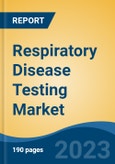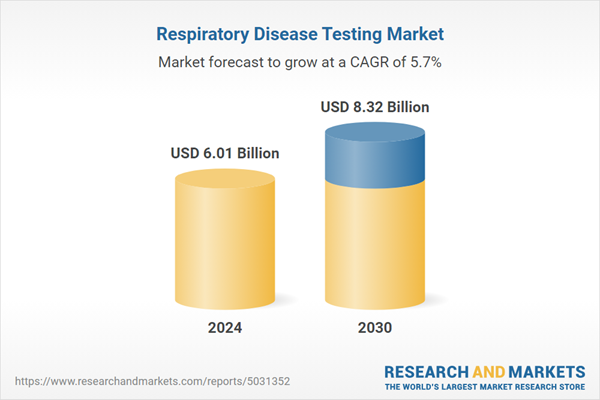Speak directly to the analyst to clarify any post sales queries you may have.
10% Free customizationThis report comes with 10% free customization, enabling you to add data that meets your specific business needs.
Transcutaneous carbon dioxide (CO₂) monitoring is used to measure CO₂ levels in the blood through the skin, helping clinicians assess respiratory efficiency. Another technique, sniff nasal inspiratory pressure (SNIP), is employed to evaluate inspiratory muscle strength, especially in patients with neuromuscular disorders. Imaging methods such as chest X-rays and computed tomography (CT) scans are crucial for visualizing lung structure, identifying tumors, infections, or fibrosis, and guiding further interventions. These imaging tools provide detailed information that supports accurate diagnosis and treatment planning.
In specific cases, sleep studies are conducted to diagnose conditions like obstructive sleep apnea and nocturnal hypoventilation, especially in patients exhibiting symptoms such as daytime fatigue, loud snoring, or interrupted breathing during sleep. These studies monitor breathing patterns, oxygen levels, and other physiological functions during sleep. The respiratory diagnostics are essential for early detection, monitoring, and management of pulmonary diseases. They not only facilitate timely intervention but also help in tailoring treatment strategies based on the individual patient’s respiratory profile, thereby improving clinical outcomes and quality of life.
Key Market Drivers
Growing Burden of Respiratory Diseases
The increasing prevalence of respiratory diseases is a significant driver for market growth. For instance, according to a 2023 article, Chronic Obstructive Pulmonary Disease (COPD) is a progressive lung condition linked to serious complications such as cardiovascular disease, respiratory failure, and lung cancer. Key risk factors include smoking, air pollution (indoor and outdoor), genetic predisposition, occupational exposures, and infections during childhood or adulthood. Factors such as the rise in smokers, alcohol consumption, sedentary lifestyle habits, and stressful routines have led to an increase in cases of COPD and other severe respiratory conditions, including lung cancer.The technological advancements in respiratory diagnostic testing, such as the utilization of Internet of Things (IoT) and Artificial Intelligence (AI) for COPD diagnosis and outpatient management, have positively impacted market growth. The growing demand for respiratory diagnostics devices in privately-owned hospitals and healthcare centers, along with the efforts of government and non-governmental organizations (NGOs) to improve access to quality healthcare facilities, are key drivers of the respiratory diagnostics market. Respiratory symptoms rank among the primary reasons for seeking medical consultation in primary healthcare centers.
Key preventable chronic respiratory disorders include asthma, COPD, allergic rhinitis, sleep apnea, and tuberculosis (particularly multi-drug resistant tuberculosis). As of September 2022, the CDC reported 873,000 emergency department visits for COPD in the United States in 2020, with 5% of adults receiving a new diagnosis of COPD, emphysema, or chronic bronchitis. These statistics underscore the growing burden of respiratory diseases on society, which is expected to drive the demand for respiratory disease testing and fuel market growth.
Key Market Challenges
High Cost and Lack of Skilled Professionals
The significant cost associated with diagnostic procedures poses a major challenge to the growth of the global respiratory diagnostics market during the forecast period. The rapid technological advancements in the field have led to a shortage of qualified specialists. The lack of competent experts has greatly hindered the proper handling of instruments and the execution of procedures. The cost associated with setting up and maintaining advanced respiratory disease testing facilities, including purchasing equipment, reagents, and maintaining quality control, can be substantial. This cost burden can discourage healthcare providers from investing in the necessary infrastructure.The high cost of establishing and operating testing facilities can lead to geographic disparities in access. Remote or underserved areas may lack the resources needed to offer comprehensive respiratory disease testing, limiting access for vulnerable populations. The specialized nature of respiratory disease testing requires trained and skilled laboratory professionals who can operate and interpret complex diagnostic equipment accurately. A shortage of such professionals can lead to delays in testing, misinterpretation of results, and overall reduced testing capacity.
Key Market Trends
Point-of-Care Testing (POCT) Expansion
The expansion of point-of-care testing for respiratory diseases will enable rapid and convenient testing in various healthcare settings, such as clinics, pharmacies, and community health centers. POCT devices will facilitate timely diagnosis and monitoring, especially in resource-limited environments. POCT devices provide rapid results, often within minutes, allowing healthcare providers to make timely decisions about patient care. In cases of acute respiratory conditions, such as respiratory infections or exacerbations of chronic diseases, quick diagnosis can lead to immediate initiation of appropriate treatment. Traditional laboratory testing involves transporting samples, processing, and result reporting, which can lead to delays.POCT devices minimize turnaround time, enabling healthcare providers to quickly assess a patient's respiratory status and make informed decisions without waiting for external laboratory results. As technology continues to advance, the development of accurate, user-friendly, and affordable POCT devices for respiratory diseases has the potential to revolutionize healthcare delivery, particularly in settings where access to traditional laboratory testing is limited. It empowers healthcare providers with actionable information and empowers patients to actively manage their respiratory health, contributing to better overall healthcare outcomes.
Key Market Players
- Beckton Dickinson and Company
- Koninklijke Philips N.V.
- ResMed Inc.
- Medtronic PLC
- Carestream Health Inc.
- MG Diagnostic Corporation
- Abbott Laboratories Ltd.
- ThermoFisher Scientific Inc.
- Biomerieux Inc.
- QIAGEN NV
Report Scope:
In this report, the Global Respiratory Disease Testing Market has been segmented into the following categories, in addition to the industry trends which have also been detailed below:Respiratory Disease Testing Market, By Test Type:
- Imaging Tests
- Mechanical Tests
- In-vitro Diagnostic Tests
Respiratory Disease Testing Market, By Application:
- COPD
- Lung Cancer
- Asthma
- Tuberculosis
Respiratory Disease Testing Market, By End User:
- Hospitals
- Diagnostic Centres
- Others
Respiratory Disease Testing Market, By Region:
- North America
- United States
- Canada
- Mexico
- Europe
- France
- United Kingdom
- Italy
- Germany
- Spain
- Asia-Pacific
- China
- India
- Japan
- Australia
- South Korea
- South America
- Brazil
- Argentina
- Colombia
- Middle East & Africa
- South Africa
- Saudi Arabia
- UAE
Competitive Landscape
Company Profiles: Detailed analysis of the major companies present in the Global Respiratory Disease Testing Market.Available Customizations:
With the given market data, the publisher offers customizations according to a company's specific needs. The following customization options are available for the report.Company Information
- Detailed analysis and profiling of additional market players (up to five).
This product will be delivered within 1-3 business days.
Table of Contents
Companies Mentioned
- Beckton Dickinson and Company
- Koninklijke Philips N.V.
- ResMed Inc.
- Medtronic PLC
- Carestream Health Inc.
- MG Diagnostic Corporation
- Abbott Laboratories Ltd.
- ThermoFisher Scientific Inc.
- Biomerieux Inc.
- QIAGEN NV
Table Information
| Report Attribute | Details |
|---|---|
| No. of Pages | 180 |
| Published | August 2025 |
| Forecast Period | 2024 - 2030 |
| Estimated Market Value ( USD | $ 6.01 Billion |
| Forecasted Market Value ( USD | $ 8.32 Billion |
| Compound Annual Growth Rate | 5.7% |
| Regions Covered | Global |
| No. of Companies Mentioned | 10 |









